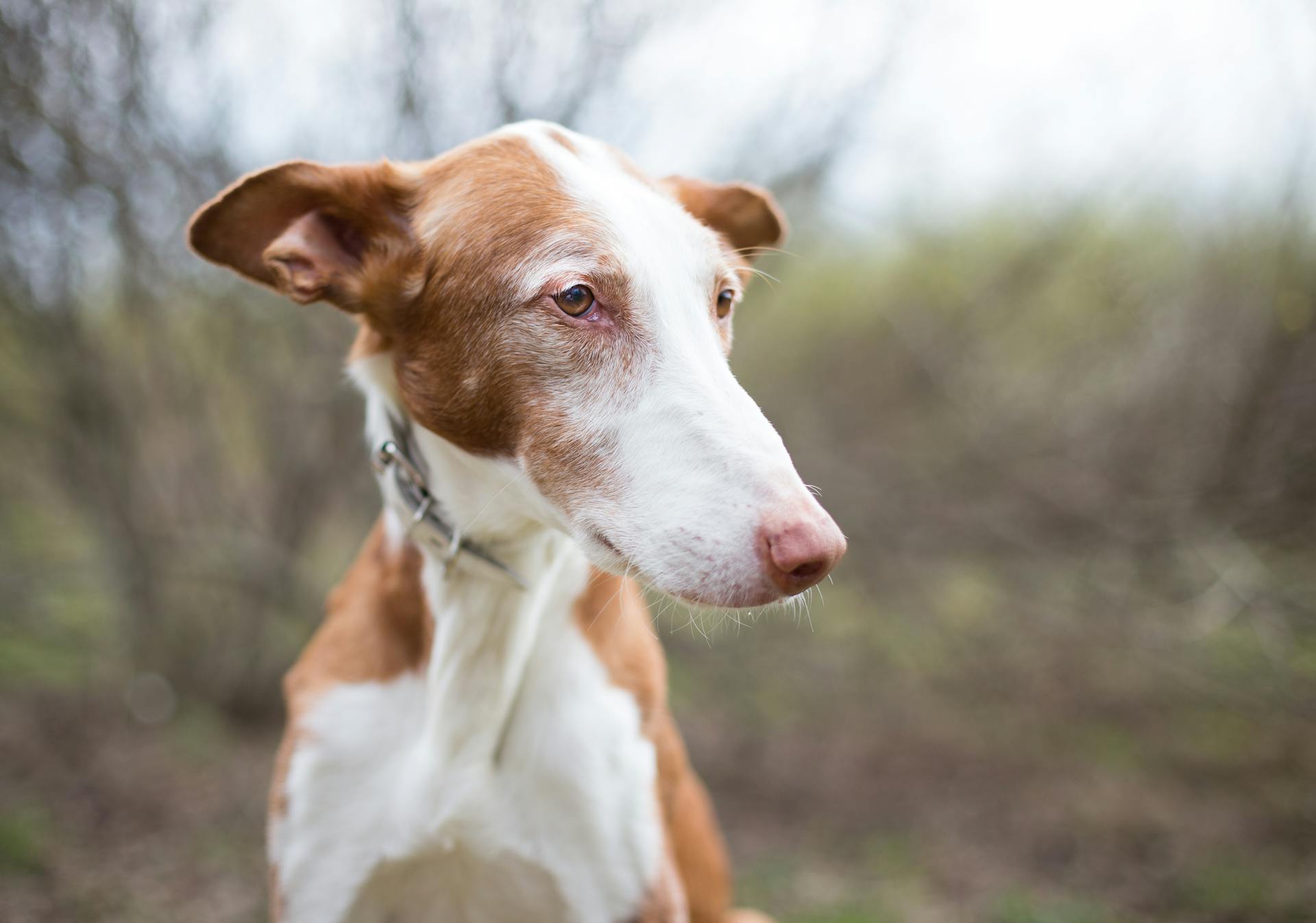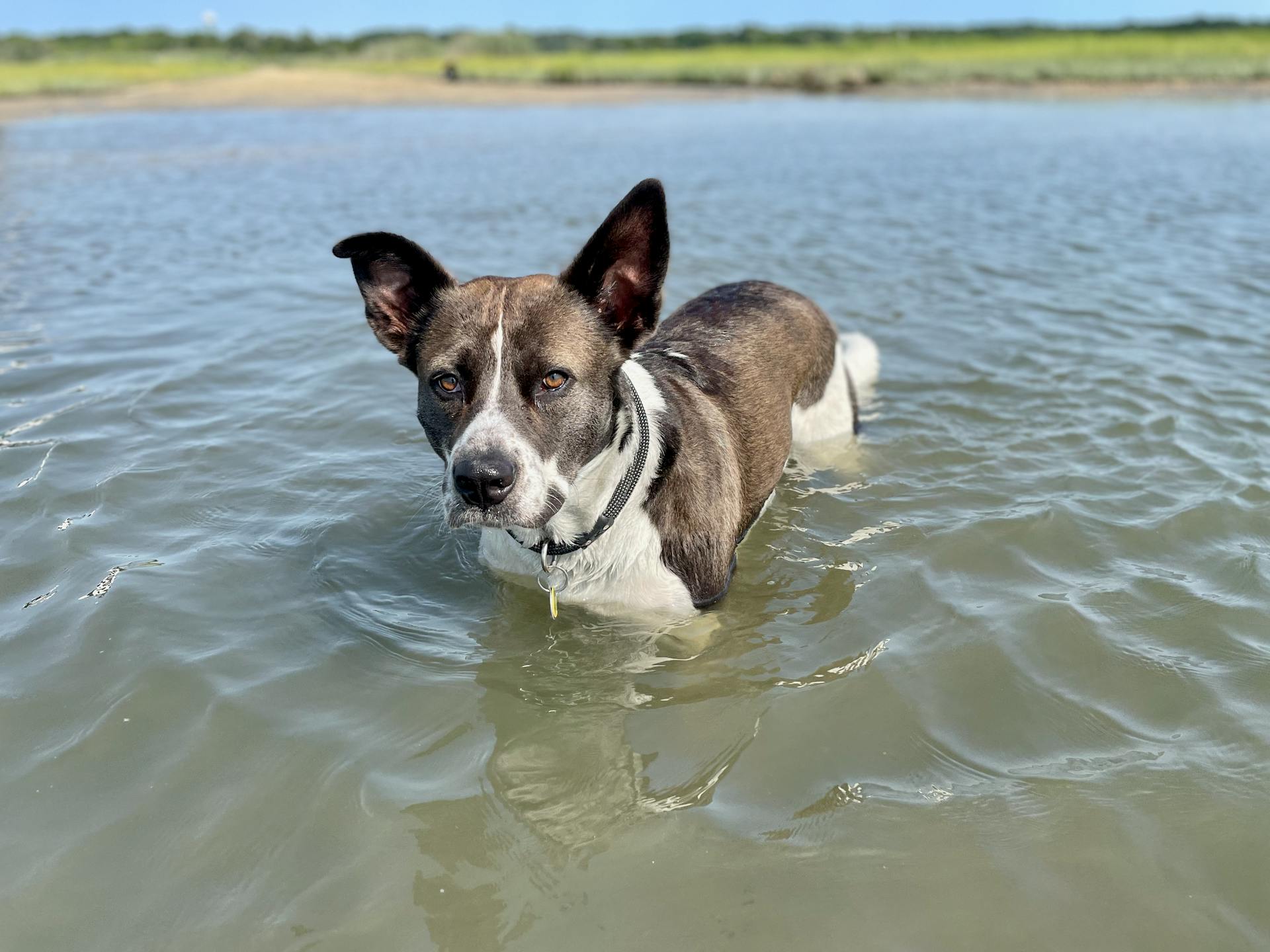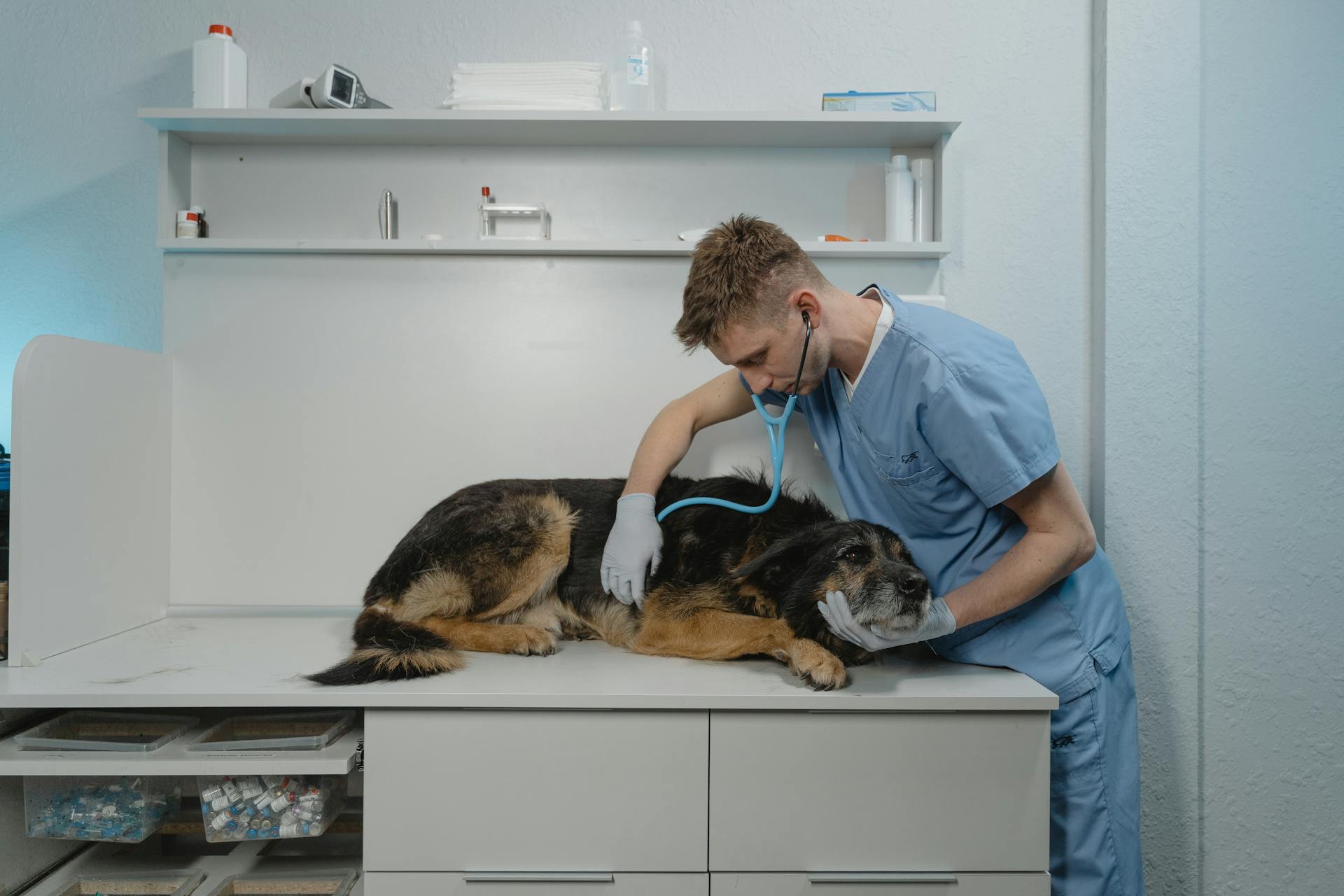
Canine lupus is a complex and chronic autoimmune disease that affects a dog's immune system, causing it to attack its own tissues and organs.
The symptoms of canine lupus can be quite varied and may resemble those of other diseases, making it challenging to diagnose.
One of the most common symptoms is kidney disease, which can lead to kidney failure if left untreated.
Dogs with lupus may also experience skin lesions, hair loss, and a characteristic "butterfly-shaped" rash on their face.
In severe cases, lupus can cause anemia, which can lead to fatigue, pale gums, and shortness of breath.
It's essential to work closely with your veterinarian to determine the best course of treatment for your dog.
Consider reading: Canine Kidney Cancer
What Is Lupus?
Lupus in dogs is a complex and multifaceted condition that can be challenging to understand. It's an autoimmune disease that affects various parts of a dog's body, including their skin, organs, and joints.
Discoid lupus erythematosus (DLE) is a type of lupus that specifically affects a dog's face, particularly the bridge of the nose, lips, and ears. In some cases, it can also affect a dog's feet and genitalia.
Systemic lupus erythematosus (SLE) is the more serious of the two types of lupus in dogs, affecting not only the skin but also organs like the heart, liver, and kidneys. This can lead to a range of symptoms, from painful joints to lameness and lethargy.
The immune system plays a crucial role in lupus, as it becomes unbalanced and starts to attack the dog's own proteins. This can lead to the formation of immune complexes, which can cause inflammation and worsen the condition.
In SLE, the immune system develops antibodies against DNA, RNA, and protein antigens, leading to the formation of immune complexes. These can become lodged in various tissues, causing symptoms such as glomerulonephritis, kidney failure, painful joints, lameness, and muscle atrophy.
Here are some common symptoms of lupus in dogs:
• Glomerulonephritis and kidney failure (if immune complexes are lodged in the kidney glomerulus)
• Painful and stiff joints, lameness, and muscle atrophy (if immune complexes are lodged in the joints)
• Anemia or clotting disorders (if red blood cells or platelets are targeted)
• Pale gums, lethargy, bruising, and bleeding from orifices (if immune complexes are lodged in the blood vessels)
A fresh viewpoint: How Long Can a Dog Live with Masticatory Myositis
Causes and Symptoms
Canine lupus is a complex disease that can affect dogs of any breed or age, but certain breeds are more prone to it. German Shepherds, Chow Chows, Siberian Huskies, Shetland Sheepdogs, Collies, Beagles, and Cocker Spaniels are among the breeds that tend to develop lupus.
Dogs with lupus may exhibit a range of symptoms, from mild to severe. Common signs of the disease include redness of the skin, especially on the nose, lips, and face, as well as scaly, flaky, or crusty skin and sores or ulcers. Other symptoms may include lethargy, loss of appetite, fever, and joint and muscle pain.
Some breeds are at a higher risk of developing systemic lupus erythematosus (SLE), which can cause a wide range of symptoms. These breeds include Shetland Sheepdogs, Old English Sheepdogs, Afghan Hounds, Beagles, Collies, Irish Setters, and Poodles. If you suspect your dog has lupus, it's essential to consult with a veterinarian as soon as possible to rule out other potential causes of the symptoms.
Signs and Symptoms

Dogs with lupus can experience a range of symptoms, from mild to severe.
Common symptoms of DLE include extreme redness, skin sores, cracking skin, loss of pigment, and ringworm on the nose.
German Shepherds, Siberian Huskies, Alaskan Malamutes, Chow Chows, Shetland Sheepdogs, German Shorthaired Pointers, and Brittany Spaniels are breeds predisposed to this type of lupus.
Dogs over 6 years of age are more likely to develop lupus, but the disease can occur at any time.
Joint and muscle pain, stiffness or lameness in the legs, lethargy, loss of appetite, hair loss, swollen lymph nodes, seizures, and sores can also be symptoms of lupus.
Shetland Sheepdogs, Old English Sheepdogs, Afghan Hounds, Beagles, Collies, Irish Setters, and Poodles are at a higher risk of developing SLE.
Symptoms of lupus in dogs can include nasal depigmentation, erythema, hair loss, scaling and crusting of the skin, skin ulcers, and itching.
Here are some common symptoms of lupus in dogs:
- Nasal depigmentation (loss of color) and loss of normal texture to the nose
- Erythema (redness) of the skin
- Hair loss
- Scaling and crusting of the skin
- Skin ulcers
- Itching
In addition to these symptoms, dogs with SLE may also experience nonspecific symptoms that can occur suddenly or come and go over time.
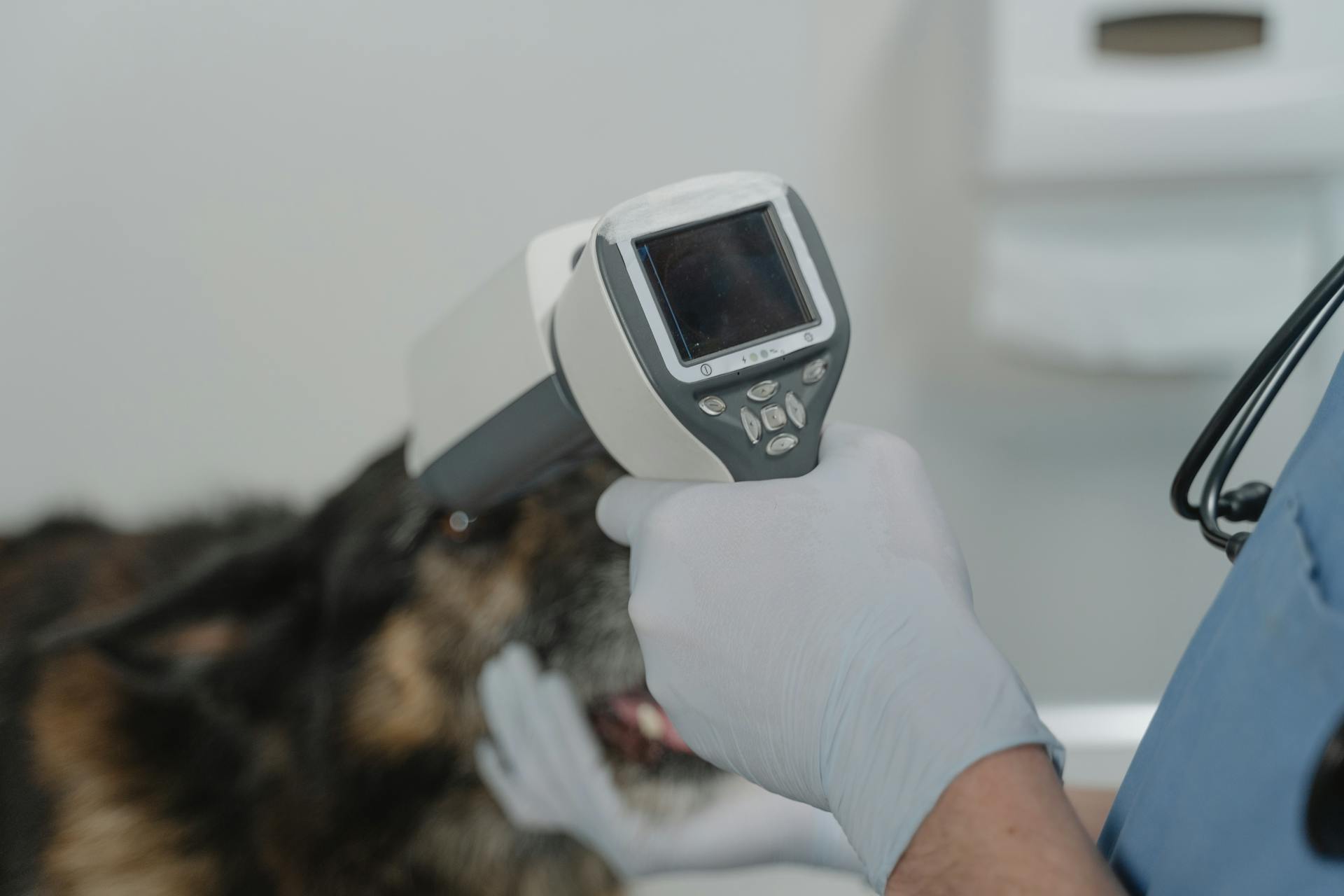
The symptoms of DLE are not terribly serious, but can still cause discomfort and pain.
Some common symptoms of DLE include pale skin on the bridge of the nose, redness of the skin, scaly, flaky, or crusty skin, sores or ulcers, scarring, pain at the affected sites, itchiness or scratching, and bacterial infections.
Causes and Symptoms
Lupus in dogs can develop in any breed and age, but it tends to occur more frequently in middle-aged dogs of certain breeds, such as German Shepherds, Chow Chows, Siberian Huskies, Shetland Sheepdogs, Collies, Beagles, Cocker Spaniels, and Boxers.
These breeds may be more prone to lupus due to a genetic factor. The disease can also be worsened by increased sun exposure, and some veterinarians believe that certain medications, viruses, and environmental factors may contribute to the development of lupus in dogs.
The sun can play a significant role in worsening lupus symptoms in dogs. This is because the disease causes the immune system to become unbalanced and uncontrollable, leading to inflammation and damage to multiple organs.
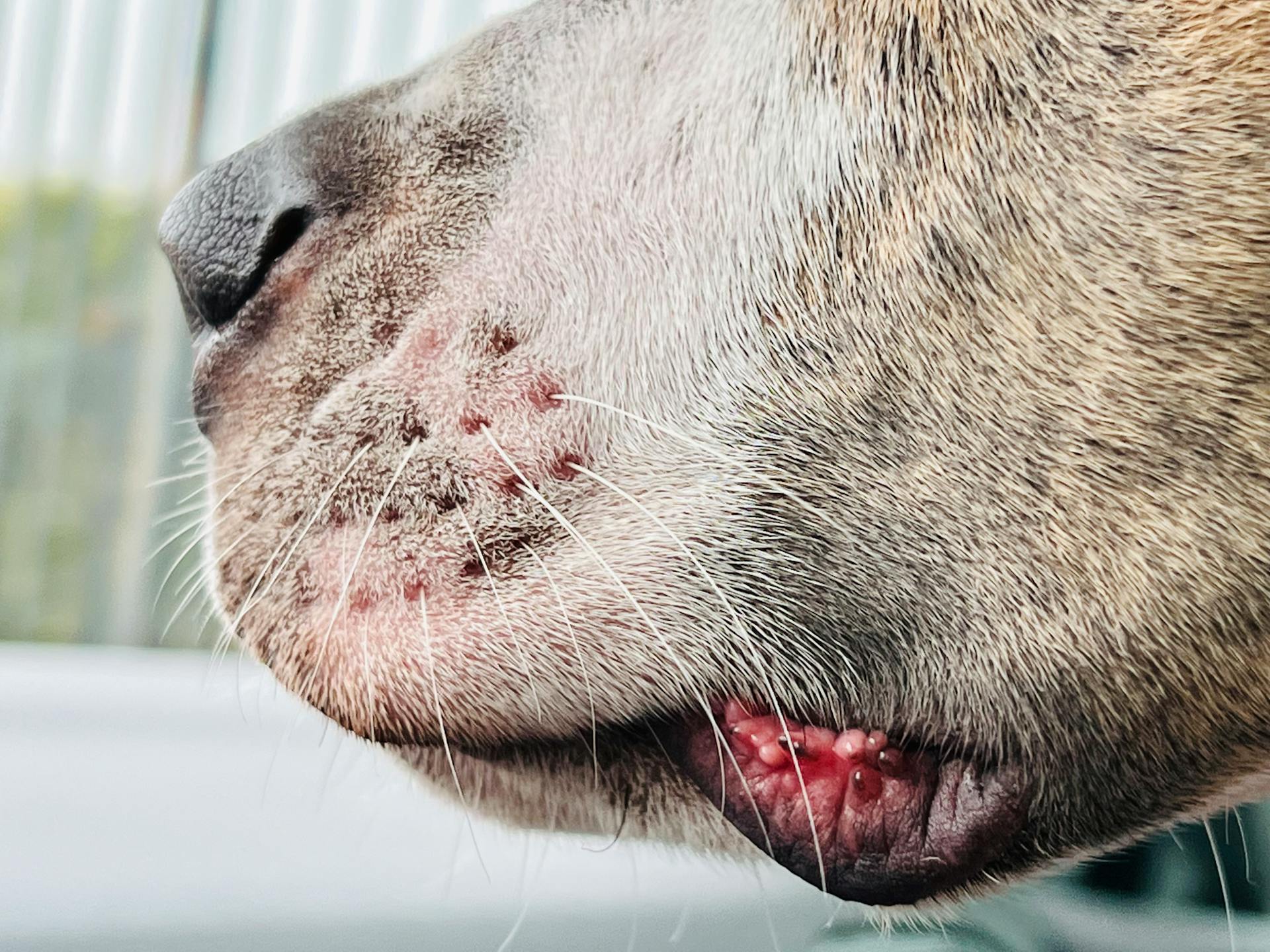
Here are some common symptoms of lupus in dogs, depending on the location of the immune complexes:
- If the immune complexes are lodged in the kidney glomerulus, the dog may develop glomerulonephritis and kidney failure.
- If they are in the joints, the dog may experience painful and stiff joints, lameness, and muscle atrophy.
- If the red blood cells or platelets are targeted, the dog may develop anemia or clotting disorders, which can show as pale gums, lethargy, bruising, and bleeding from orifices.
In addition to these symptoms, dogs with lupus may also experience lesions on the face, such as on the lips, nose, around the eyes, and ears.
Diagnosis and Treatment
Diagnosing canine lupus can be a challenge due to its similar symptoms with other autoimmune diseases. Your veterinarian will perform a physical exam and may recommend bloodwork and urine testing to rule out other conditions.
To diagnose lupus, veterinarians may use various tests, including the Coombs test, ANA test, LE cell test, and immunofluorescence testing. These tests can help identify antibodies and immune complexes that are characteristic of lupus.
A skin biopsy may also be performed to diagnose DLE, while a combination of symptoms and blood tests are used to diagnose SLE.
Treatment for canine lupus typically involves managing symptoms and preventing flare-ups. This may include using immunosuppressive drugs, such as steroids, to block the immune system and reduce inflammation.
Check this out: Canine Brucellosis Test

Some common side effects of steroid use include increased thirst and urination, gastrointestinal upset, and an increased risk of infection. To minimize these side effects, other immunosuppressive drugs may be used in combination with steroids.
Here are some common immunosuppressive drugs used to treat lupus:
- Azathioprine
- Chlorambucil
- Mycophenolate
- Cyclosporine
- Leflunomide
In addition to medication, veterinarians may recommend topical therapies, such as ointments or shampoos, to help manage skin lesions. Sun protection is also crucial, as sunlight can exacerbate symptoms.
Diagnosing
Diagnosing lupus in dogs can be a challenging process due to the similarity of its symptoms with other autoimmune diseases. Your veterinarian will take notice of any symptoms your pup may have been experiencing during a physical exam.
A skin biopsy can be used to diagnose DLE, which involves taking a sample of your dog's skin to analyze for signs of the disease. Your vet may recommend bloodwork and urine testing to rule out other diseases.
Blood tests can help distinguish lupus from other diseases, such as kidney disease and cancer. The antinuclear antibodies (ANA) test is one way to do this, and if your dog tests positive, it can be a differentiating factor.
Your vet may also perform other tests to look for antibody and immune complex formation, including the Coombs test, ANA test, Lupus erythematosus (LE) cell test, and Immunofluorescence testing.
Here are some of the tests your vet may use to diagnose lupus in dogs:
- Coombs test: looks at antibodies targeted against red blood cells
- ANA (antinuclear antibody test): looks for antibodies targeted against nuclear (DNA) antigens
- Lupus erythematosus (LE) cell test: looks for white blood cells that have engulfed nuclear material
- Immunofluorescence testing: looks for evidence of certain antibodies
To diagnose SLE, your vet will likely do a blood test to narrow down what's going on, and it's essential to keep track of all your dog's symptoms to help with the diagnosis.
Treatment
Treatment is a crucial part of managing canine lupus. There are various options available, but it's essential to work closely with your veterinarian to determine the best course of action for your dog.
Lupus is a chronic illness, and treatment will need to be ongoing for the rest of your dog's life. In some cases, treatment may involve a combination of medications and lifestyle changes.
Explore further: Canine Leishmaniasis Treatment
Prescription medications called immunosuppressants can help block the immune system, which is overactive in dogs with lupus. Steroids, at high doses, are often prescribed and are the most effective treatment option, but they can have negative side effects.
To minimize these side effects, other immunosuppressive drugs may be used with steroids, such as Azathioprine, Chlorambucil, Mycophenolate, Cyclosporine, and Leflunomide.
Limiting sun exposure is also crucial, as it can aggravate symptoms. Protect your dog by keeping them out of the sun as much as possible, especially during peak hours, and use a pet-approved sunscreen on non-haired skin.
In addition to medication, topical therapies can be used to treat localized lesions. Topical ointments with tetracycline-niacinamide or tacrolimus are good options, and sun exposure can make lesions worse, so limit sun exposure as much as possible.
Antibiotics may also be prescribed to treat secondary skin infections, which are common in dogs with lupus. These can include Cephalexin, Clavamox, Clindamycin, and Antifungal medications like fluconazole or miconazole.
Fatty acid supplements can help maintain the skin barrier and reduce inflammation, and prescription diets can help support your dog's immune system.
Here are some common immunosuppressive drugs used to treat lupus:
- Azathioprine
- Chlorambucil
- Mycophenolate
- Cyclosporine
- Leflunomide
Remember, every dog is different, and the best treatment plan will depend on your dog's specific needs and medical history. Consult with your veterinarian to determine the best course of action for your dog.
Frequently Asked Questions
How long can a dog live with lupus?
Dogs with lupus can live for the rest of their lives, but ongoing management and treatment are necessary to control symptoms and improve quality of life. Lifelong care and monitoring are crucial for managing canine lupus.
What dog breeds are prone to lupus?
Several dog breeds are prone to lupus, including German Shepherds, Beagles, Afghan Hounds, Collies, Poodles, and Irish Setters. Genetics may play a role in the development of lupus in these breeds
What happens if lupus goes untreated in dogs?
If left untreated, lupus in dogs can lead to potentially fatal complications and a painful death. Prompt veterinary attention is crucial to prevent these severe outcomes.
Is lupus common in German shepherds?
German shepherds are one of the breeds predisposed to developing Systemic Lupus Erythematosus (SLE). While not all German shepherds will develop SLE, their breed status means they may be at a higher risk.
What triggers lupus flare-ups in dogs?
Lupus flare-ups in dogs can be triggered by environmental factors such as ultraviolet light and cigarette smoke, as well as stress and immunologic disorders. Identifying these triggers is crucial in managing the disease and preventing future flare-ups.
Sources
- https://canna-pet.com/articles/lupus-dogs-signs-symptoms-causes/
- https://vetfocus.royalcanin.com/en/scientific/canine-cutaneous-autoimmune-disease
- https://www.vetlexicon.com/canis/dermatology/articles/systemic-lupus-erythematosus/
- https://www.petmd.com/dog/conditions/immune/lupus-dogs
- https://www.metlifepetinsurance.com/blog/pet-health/what-you-need-to-know-about-canine-lupus/
Featured Images: pexels.com

